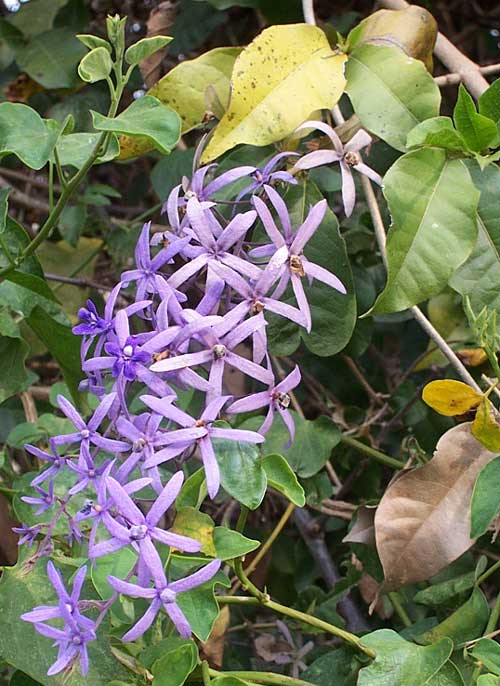Excerpts from Jim Conrad's
Naturalist Newsletter
from the March 17, 2007 Newsletter issued from Sierra Gorda Biosphere Reserve, QUERÉTARO, MÉXICO
QUEEN'S WREATH FLOWERING
Here and there you see a woody vine climbing into trees producing long, slender clusters of pretty, purple flowers. It's the Queen's Wreath, PETREA VOLUBILIS, of the Verbena Family. Those are its flowers below:

This is a native tropical-American vine but it's so pretty that it's grown worldwide. Last year at San Juan in the Yucatán the large trellis over the patio next to the hacienda house supported a large Queen's Wreath that grew like a grapevine. I'd like to sit in its shade right now sipping tea and admiring its foot- long, purple clusters of star-shaped blossoms dangling into the dimness below, charming the whole sitting space. This fine plant can twine up to 40 feet if it's kept watered and has plenty of sun.
The vine is so admired by tropical gardeners that it's been horticulturalized into a number of showy forms. One curiosity about the blossoms is that the flowers' slender "petals" aren't petals at all, but rather colored sepals -- calyx lobes -- that serve the function of petals, which is to attract pollinators with their color. In my photograph you can see inconspicuous corollas in the blossoms' centers.
Corollas typically last only for one or two days, but the petal-like ("petaloid") sepals persist for a good while, often gradually fading to tan as they mature. In my picture you can see how the tiny corollas in the blossoms' center at the bottom of the inflorescence haven't yet opened, just two or three at the inflorescence's center have expanded, and then in the older blossoms at the flower cluster's top the old corollas are shriveled and brown, though the petaloid sepals show little age at all.
This vine's leaves are so leathery and rough that often the plant is known as Sandpaper Vine.